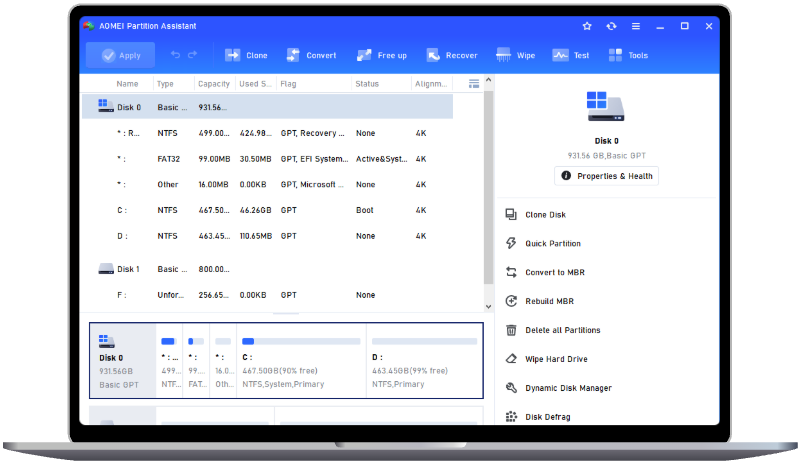How to Fix Local D Drive Keeps Poping Error [6 Ways]
Have you ever encountered the local Ddrive keeps popping error? In this article, you will learn why these errors happen and how to fix them easily and quickly.
Common errors encountered on the D drive
The D drive, commonly used as a secondary storage partition on computers, often encounters various errors that can disrupt data access and storage. Here are some of the most common issues users face:
1. D drive not recognized
This error occurs when the operating system fails to detect the D drive. It can manifest as the drive being missing in File Explorer or Disk Management.
2. Drive is not accessible
An error message like "D:\ is not accessible" may appear, often accompanied by additional warnings such as "Access is denied" or "The file or directory is corrupted and unreadable."
3. D drive running out of space
Unexpectedly low storage space on the D drive can occur due to unmanageable file sizes, hidden files, or unwanted programs accumulating over time.
4. Partition missing
The D drive partition may disappear entirely, leaving users unable to access the data stored on it. This often results from partition table corruption or accidental deletion.
5. RAW drive format
In some cases, the D drive may switch to a RAW format, making the data inaccessible. Windows may prompt users to format the drive, which risks data loss.
6. Read-only drive
The D drive may become read-only, restricting users from modifying or deleting files. This is often caused by permission changes or drive attributes being altered.
These errors can significantly impact productivity and data safety, emphasizing the importance of regular drive maintenance and error checks.
Why does the local D drive keep popping errors?
The local D drive might keep popping errors for several reasons:
▸ File system corruption: The file system on the D drive could be damaged, preventing it from properly reading or writing data.
▸ Bad sectors: The drive may have developed bad sectors, which are sections of the disk that can no longer store data reliably.
▸ Disk space issues: If the D drive is running out of space, it can lead to frequent errors when trying to save or process files.
▸ Hardware failures: Physical issues, such as a failing hard drive or loose connections, can cause errors to repeatedly appear.
▸ Driver problems: Outdated or incompatible drivers for the hard drive or disk controller can interfere with proper functioning.
▸ Virus or malware: Malicious software can corrupt data or disrupt the operation of the D drive.
▸ Logical partition issues: The partition on the D drive may have been misconfigured or damaged, causing frequent problems.
Each of these factors can contribute to recurring errors on the D drive, disrupting its normal operations.
How to fix local D drive keeps popping error
If you're facing issues with your Local D drive and it's repeatedly popping up with errors, there are several troubleshooting steps you can follow to resolve the problem.
Fix 1. Run Disk Cleanup
Disk Cleanup is a built-in tool in Windows that helps free up space on your drive by removing unnecessary files, which might be causing the error. Here's how you can use it:
Step 1. Type "disk cleanup" in the search box on the taskbar, and select Disk Cleanup from the list of results.
Step 2. Select your local D drive, and then select "OK".
Step 3. Under "Files to delete", select the file you want to get rid of, and click "OK".
Step 4. To free more space, you can use “Clean up system files”. With this function you can remove older Windows restore points from your drive, leaving only the most recent one.
Fix 2. Run CHKDSK via Command Prompt
CHKDSK is a command-line tool that checks the integrity of your drive and repairs any issues. Here's how to use it:
Step 1. Press Windows + X and select Command Prompt (Admin) or Windows PowerShell (Admin).
Step 2. Type the following command and press Enter:
chkdsk F: /f /r /x (Here take F drive as an example)
The /f parameter fixes any errors found.
The /r option locates bad sectors and recovers readable information.
The /x option forces the drive to dismount before scanning.
Step 3. Allow CHKDSK to complete the scan and repair any issues. This may take some time depending on the size of your drive.
Fix 3. Check disk errors with a third-party tool
While the methods mentioned earlier can be effective for disk checking, some users may encounter issues such as CHKDSK freezing at 100%, the scan and repair process getting stuck in Windows 10/11, or even the system becoming unresponsive. In such cases, using a professional third-party tool to check for disk errors in Windows 10 is a good solution.
AOMEI Partition Assistant is a reliable, free partition management tool that allows you to safely and efficiently check partitions and disks. It is compatible with Windows 11, 10, 8, 8.1, and 7, and can be downloaded for free to give it a try.
Step 1. Install and run the freeware. Right-click the drive partition and choose "Advanced" > "Check partition".
Step 2. Choose a way of checking disk error, the first one is always chosen by default.
Step 3. Wait for a while, the check process will be done.
Fix 4. Update drivers
Outdated or corrupt drivers can also cause issues with your Local D drive. Here’s how to update them:
Step 1. Press Windows + X and choose Device Manager.
Step 2. Expand the Disk Drives section.
Step 3. Right-click on your Local D drive and select Update Driver.
Step 4. Choose Search automatically for updated driver software.
Step 5. Follow the on-screen instructions to install the latest drivers.
Fix 5. Scan for malware
Malware or viruses can cause unexpected errors on your Local D drive. Perform a full system scan to detect and remove any threats:
Step 1. Press "Windows + I" at the same time to open the Settings window and click "Update & Security".
Step 2. Select "Windows Security" on the left panel and choose "Open Windows Security".
Step 3. In Windows Security window, go to "Virus & threat protection" > "Scan options".
Step 4. Select "Microsoft Defender Offline scan", and then click "Scan now".
Fix 6. Reassign the drive letter
If the drive letter of your Local D drive is causing conflicts, you can change the drive letter to reassign it:
Step 1. Press Windows + X and select Disk Management.
Step 2. Locate your Local D drive in the list of drives.
Step 3. Right-click on it and select Change Drive Letter and Paths.
Step 4. Click Change, choose a new drive letter, and click OK.
Step 5. Confirm the change and restart your computer.
Conclusion
In conclusion, errors on the D drive can arise from issues like file system corruption, bad sectors, malware, or hardware problems. To fix these, you can use tools like Disk Cleanup, CHKDSK, and third-party software like AOMEI Partition Assistant. Updating drivers, scanning for malware, and reassigning drive letters can also help resolve frequent errors. By following these steps, you can restore your drive’s performance and safeguard your data.


